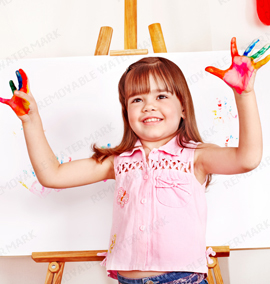
Born in 1870, Maria Montessori battled against many of the prejudices of her time to become the first female doctor in Italy. Through her work as a physician, specialising in psychiatry and anthropology, she became interested in how children develop, and particularly their instinctive effort to learn about their environment through their hands.
In 1906, Maria Montessori set-up an infant school, Casa dei Bambini, for 3-7 year olds in the slum area of Rome. Through the use of special learning equipment and skillful guidance, Dr. Montessori was able to build the children's self-esteem, helping them to become motivated and self-disciplined individuals. News of the school's success soon spread helping to revolutionise the conventional teaching methods of the time. Her research into children's development and education has stood the test of time, with thousands of Montessori schools now operating throughout the world. The Montessori approach uses a well-prepared environment, and a skilled teacher, to help each individual child to achieve their fullest potential at their own unique pace.
A sense of community life is important in helping young children to develop social skills, self-esteem and care and respect for others. Although the Montessori method encourages a freedom of choice and movement, it also makes sure that this 'freedom' is set within limits, ensuring a respect for peers and for the classroom environment. The teacher guides each child towards activities which are suited to his/her level of development. He/she is then encouraged to complete the activity, working at his/her own pace. Children learn to take care of their specially-prepared classroom, helping to put materials back in their proper place. They also learn to respect each other's work space by either waiting for their turn, or by asking to share in an activity.

All our teachers produce Progress portfolios on each child which includes evidence of how each child is achieving each EYFS objective for their age group. This evidence is formed through many different techniques and mediums, For Example; written observations, photos, group observations, videos, voice recordings etc.
A unique aspect of a Montessori class is that children of mixed ages work together in the same space; the children in our Montessori classes range in age from 2½ to 4½ years old. This encourages children to learn from each other and gives them a wider choice of activities in the classroom. The older children learn patience and tolerance as they teach their younger peers a new piece of knowledge (and so reinforce and perfect their own understanding). Meanwhile, the younger children learn from an early age how to work alongside their peers and grow in self-confidence as they are inspired to try out new things. Dr. Montessori's research shows that putting children of mixed ages together creates a natural 'family' atmosphere, where children feel secure and learn important life-long skills of living and working together successfully.

Maria Montessori observed that children develop through a series of "sensitive periods", where they are particularly sensitive to certain aspects of the environment at that moment. It is during these sensitive periods, which may only last a short time, that children have the greatest ability to learn. For example, a 2½-year-old child may watch with interest as an older friend enjoys a counting game. Our teachers are trained to spot this 'readiness for learning' and would encourage the younger child to develop his/her interest by working with maths materials. With the classroom set out into six key areas of learning, the Montessori approach means that each child can develop their intellect and creative potential to the fullest, at any given moment in their development.
A specially-prepared classroom
Each of our Montessori classrooms is divided into six work areas:
o ART: developing creative skills through paints, books, play dough etc.
o PRACTICAL LIFE: using everyday materials to develop concentration; independence; and fine and gross motor skills.
o SENSORIAL: helping children to recognise and respond to changes in sound, smell, sight, touch and taste.
o LANGUAGE: introducing the phonic sounds and going on to develop reading and writing skills.
o MATHEMATICS: using attractive materials to introduce numbers and quantities, progressing on to simple operations of addition and subtraction.
o CULTURE: using puzzles, models, matching exercises and experiments to explore biology, geography, history and science.
The materials in all of these areas are designed to present concepts in their concrete form, helping children to learn by doing. For example, children learn the phonetic sounds of the alphabet by drawing them in the sand, so that they are not only learning through sight but also through touch. The idea that the path to intellectual development is linked through the hands is a major theme in Maria Montessori's method of teaching.

The different areas of the classroom are introduced to the children through group presentations and also on an individual basis. The freedom of choice within a safe and secure environment means that there is plenty of opportunity for the teacher to give one-on-one attention. Our Montessori teachers carefully chart the progress of each child, helping them to achieve their goals. They gently encourage children to move on to the next level once they have perfected a particular activity.
Similarly, if a child is struggling they will be able to suggest activities to build their confidence, preparing them for future tasks. For example, if a child is finding it difficult to hold a pencil, the teacher would guide them towards work with Practical Life equipment such as using tweezers to pick up objects; threading beads; using a medicine-dropper; modelling with play dough and cutting with scissors. They may also encourage work with materials like the knobbed cylinders in the Sensorial area, which require a three-finger 'pincer-grip'. Gradually, these activities will help to develop the small muscles in the child's hand, better preparing them for writing.